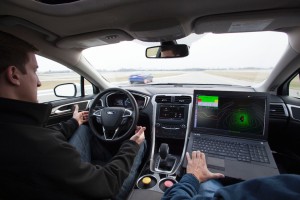
Self-driving vehicles may improve the mobility of baby boomers some day, if they learn to trust the vehicles.
Technology is playing a bigger role than ever in the car-buying experience, whether it’s the technology on the car making it safer or easier to drive or the technology used to determine what vehicle is best for the buyer.
In today’s highly connected lifestyle, new vehicles are laden with more and more safety and convenience features. However, according to a new study from Jumpstart Automotive Group, many of those digital mavens rate state-of-the-art technology and infotainment as “nice-to-have” feature versus a “must have.”
This may be because the bar is higher. Consumers’ expectations are much more advanced today—they expect their vehicle to be an extension of their connected live, the study notes. This is especially true of Bluetooth, which many list as a favorite technology that they would be unwilling to give up.
The top five influencers when it comes to leasing or buying a new vehicle are quality and reliability (34%), gas mileage (29%), price point (28%), brand reputation (25%) and safety (19%). However, that changes depending upon which age group is doing the buying.
(Long decommissioned: Route 66 lives on. For more, Click Here.)
Drivers 50 and older have a bigger focus on safety and technology, according to a new survey from The Hartford insurance company. In fact, 76% of drivers over 50 are looking for cars with the latest safety equipment.

Technology plays a role in every aspect of the automotive industry whether it is buying or driving a vehicle.
“Our findings indicate that some drivers, age 50-plus, would be more willing to drive in certain situations if they had particular technologies,” said Jodi Olshevski, a gerontologist and executive director of The Hartford Center for Mature Marketing Excellence. They study suggests “they associate advanced technologies with enhanced safety,”
They are looking for advanced safety features like blind-spot warning, crash mitigation, lane-departure warnings and advanced headlights. However, the survey suggested that counter to other findings, this group is open-minded when it comes to the ultimate in automotive technology: autonomous vehicles.
While a quarter said, “No thanks,” the rest of the group was willing to give self-driving vehicles a try (35%) or didn’t know enough about them (42%) to make up their mind.
(Street drag racing to be a feature of 2016 Woodward Dream Cruise. Click Here for the story.)
However, to sway them to the “yes” side of the aisle, 56% said they needed to know that it would be as safe as if they were behind the wheel, 48% would use them to get around if their health prevented them from driving and 27% would use them if it they better enabled them to stay connected to friends.
Still finding a car, whether you drive it or a computer hooked to sensors handles the chore, takes time and effort.
And technology, in an increasing number of cases. Jumpstart found that 80% of people research online throughout the entire process. The percentage risess to 88% for Millennials. From initial brand consideration all the way through to purchase, consumers rely most heavily on dealer sites (37%), Google searches (34%), and auto research sites (30%) as the top three sources for their information. Rounding out the top five are Consumer Reports and OEM sites.
The information pulled runs the gamut, but technology users tended to use specific resources for different information.
(Jeep electrified. SUV maker planning plug-ins, EVs. Click Here for more.)
Three-fourths look to OEM and auto research sites for pricing and finance information, and nearly half rely on these sites for fuel economy and vehicle comparison information. When determining the reliability of a vehicle, 29% of consumers indicate that they turn to auto research sites and 26% use OEM sites.
